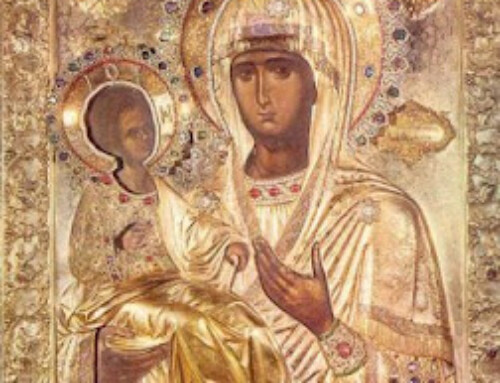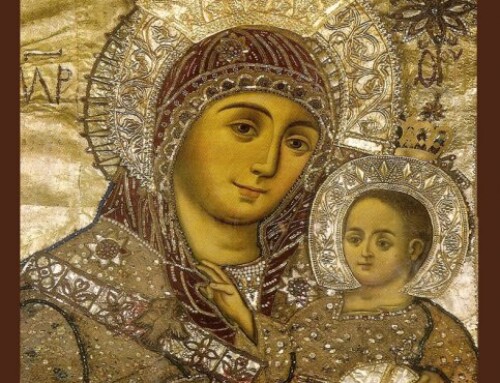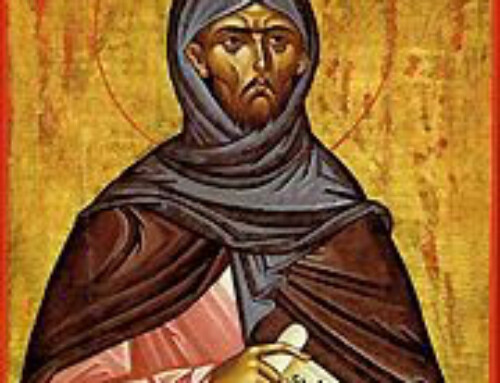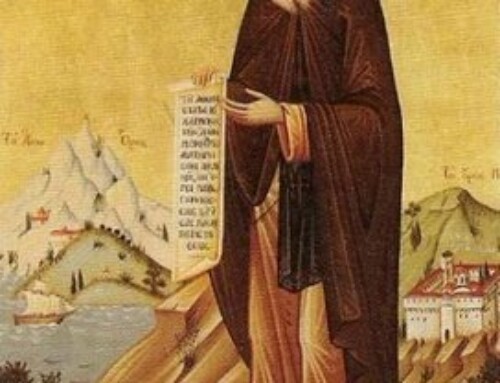Word Magazine April 1999 Page 16/21
THE TROPHY-BEARER GEORGE
By Seminarian Bassam Nassif
The Saints are ordinary people who love God and live in communion with Him. As the cave of Bethlehem, the center of the world, accepted the baby Jesus to rule the earth, the hearts of the saints humbly accept the living Lord to rule their life. Following the commandments, “Be ye holy for I am holy” (1 Pet. 1:16), and “Be ye perfect just as your Father in heaven is perfect” (Mat. 5:48), their lives become a theophany, a manifestation of God’s power on earth. After much spiritual struggle, they become by the Grace of God role models of sanctity for us to emulate. The Orthodox Church does not “make” someone a saint. She simply recognizes and proclaims sanctity. Some of the marks of sanctity are distinguished service to the Church, profound living faith, a life that manifests fruits of the Spirit, genuine martyrdom, and possible miracles.
It is said that the feast days of saints helped form the identity of particular communities. One wonders why some saints have a special impact on the life of particular communities. Saint George, for example, is popular throughout the world, but especially in the east, within the Patriarchate of Antioch. This is noticed from the large number of churches, monasteries and shrines that carry his name. In Lebanon alone, two hundred and eighty parishes and twenty-eight monasteries are dedicated to Saint George. That’s by far the largest number of Christian churches named after one saint in Lebanon. In the early sixties, the Arab Orthodox immigrants to America had forty-three (of eighty-three) churches and four (of five) cathedrals dedicated to Saint George. The special devotion that the Antiochian faithful have to this particular saint is an indicator of how much the saint continues to impact their lives. So who is Saint George, and why did his life influence not just Christians but all the people of the Middle East in a unique way?
According to tradition, George was born of a father from Cappadocia (Asia Minor), and a mother from Lydda, a village between Jerusalem and Jaffa (Palestine). He was born at the end of the third century and was raised in Lydda. Both of his parents were devout Christians. From his childhood, his parents planted in George the love of God through their example of piety and devotion. At age seventeen, George joined the Roman army. Being highly disciplined and distinctly courageous, he was quickly elevated to the rank of commander of a thousand troops. Stationed in Nicodemia (Asia Minor, on the sea of Marmara), he was directly under Diocletian, the Roman pagan Emperor. When this Emperor issued a decree enforcing the worship of Roman idols and persecuting Christians, George seized the opportunity to witness the faith. Recognizing that the kingdom of heaven is violently taken by force (Mat. 11:12), our brave soldier put on the whole armor of God (Eph. 6:11). Along with two other commanders, Marcelle and Maurice, he stood up and denounced Diocletian for his decree, confessing his Christian faith. The Emperor highly regarded George as his best commander. So he used all kinds of evil tactics to convince George to deny Christ. He gave him many deceiving promises of power and wealth, and even threatened him. To show the seriousness of his threats, Diocletian beheaded George’s two friends, Marcelle and Maurice. But our saint feared no earthly ruler, because his real ruler is the King of heaven. Seeing his unshakable faith, the Emperor physically tortured George by tying his body to the wheel, throwing him into a boiling furnace, and many other terrible tortures. The saint endured everything by the power of God. After every torture, the angel of the Lord appeared and healed him. The Lord resuscitated him four times.
Seeing these miraculous signs, thousands of Romans were guided to the Christian faith. The most prominent convert was Alexandra, the wife of Diocletian, who was beheaded (feast day, April 21). Later on, Saint George was taken by force to the pagan temple. As soon as he entered, he simply uttered the powerful name of Jesus, and the temple crumbled, killing many pagan worshippers. Finally, in a hopeless move, the emperor Diocletian beheaded his bravest commander around the year 303 AD in Nicodemia.
George’s martyrdom story touched many lives in his era, and his fame spread everywhere in the great Roman Empire. His holy relics performed miracles by the power of the Holy Spirit. After Emperor Constantine’s edict of freedom of religion in 313 AD, churches dedicated to Saint George were erected upon ruins of Roman pagan temples in Syria, Phoenicia, Palestine, and Egypt. Constantine himself erected Saint George’s Church in his city, Constantinople (Istanbul), which later became the residence of the Ecumenical Patriarchate. In the sixth century, the Emperor Justinian built a great church in honor of the saint in Lydda, and translated his relics to this cathedral (Translation feast, November 3). Throughout the east, faithful asked for his intercession, especially in dangers of war, persecution, and famine. Church Fathers such as Saints Basil the Great, John Chrysostom, Ambrose (fourth century), Gregory the Great (seventh century), and Andrew of Crete (eighth century) wrote hymns to honor his memory. Not only the east, but the whole inhabited world honored Saint George. He became the patron saint of many countries such as England, Portugal, Greece, etc.
In a region that suffered continuous political unrest and religious persecution, the people of Antioch saw in Saint George a symbol of their struggle, a type of heroic passive resistance leading to a triumph by the power of God. The account of his martyrdom, handed down to us in the oral tradition, became the story of entire Christian nations and cities, and of persons. The faithful of the “Confessing Church” of Antioch saw in everything the saint endured, from physical tortures and trials to persecution and captivity, as the story of each of them. Thus, his resistance became their way of resisting, hoping that his triumph would become their triumph as well.
The continuous struggle of the eastern Christians against their tyrannical unchristian rulers was later depicted in icons of Saint George slaying the dragon. Saint George became “the deliverer of captives” who were held by the tyrant beast. This story did not appear until the ninth century, after the rise of Islam in the eastern land of the Roman Empire. Some recounted that there was a dragon terrorizing a city called Sylene in Libya. The beast demanded a daily human victim to quench its hunger. Once the lot fell on the King’s daughter. It happened that our great commander George was passing by; hearing of the terrifying news, he made the sign of the cross, galloped towards the dragon and slew the beast, saving both the King’s daughter and the entire city from the dragon’s tyranny and terror. As a result of this miraculous triumph and deliverance, the inhabitants of the city converted to Christianity along with their King.
Later on, the citizens of Beirut (Lebanon) took up this story and claimed it as their own. They insisted that the slaying of the dragon happened in the Bay of Saint George, on the northern coast of Beirut. Subsequently, the governor of Beirut and all its inhabitants were baptized. To commemorate this event, they transformed the cave which was the hiding place of the dragon into the shrine of both Saint George and the Theotokos. Consequently, a church of Saint George, the new patron saint of Beirut, was erected on this site, and on its walls frescos depicted the story of the slaying. In front of the altar there was a marble pillar on which was written that Saint Helen (the mother of Emperor Constantine) erected this church. Local tradition says that Saint George washed his hands near the cave of the dragon, in a fountain which became miraculous. To this day, this fountain emits a foam similar to soap, which has the power of healing.
Another famous shrine of Saint George is the Orthodox monastery of Houmaira, Wadi El-Nasara (Syria). The original church was built in the sixth century upon the ruins of a pagan temple consecrated to the pagan god Homera. Some claim that Emperor Justinian built it. But the importance of the monastery lies in its geographic location. It is on the Roman road frequented by travelers of that time. Countless accounts of miracles and spiritual healing occurred to the travelers through the intercessions of Saint George. The latest recorded miracle happened in 1961. A paralytic man was healed in the monastery. He saw a vision of Saint George riding his white horse, ordering him to get up and walk. Saint George has always been called by the Church the “healer of the infirm.”
Almost every shrine of Saint George has accounts of extraordinary events experienced by the local faithful. Thus Saint George continues to slay new dragons. And the East continues to record events of persecution. It seems that God intentionally ordained to reveal the life of Saint George, who was the last and greatest Christian Martyr before the edict of Constantine. God wanted us to keep the memory of a bright and young Christian faithful who lived in a time of great persecution, suffered great tortures, and was beheaded for Christ’s love. Although the commander George was beheaded, his death was a passage to heavenly life. Thus George finally triumphed. And the people of Antioch continue to live in the hope of the triumph over their spiritual enemies by the God of their “Victorious Great Martyr George, the Trophy Bearer.”





